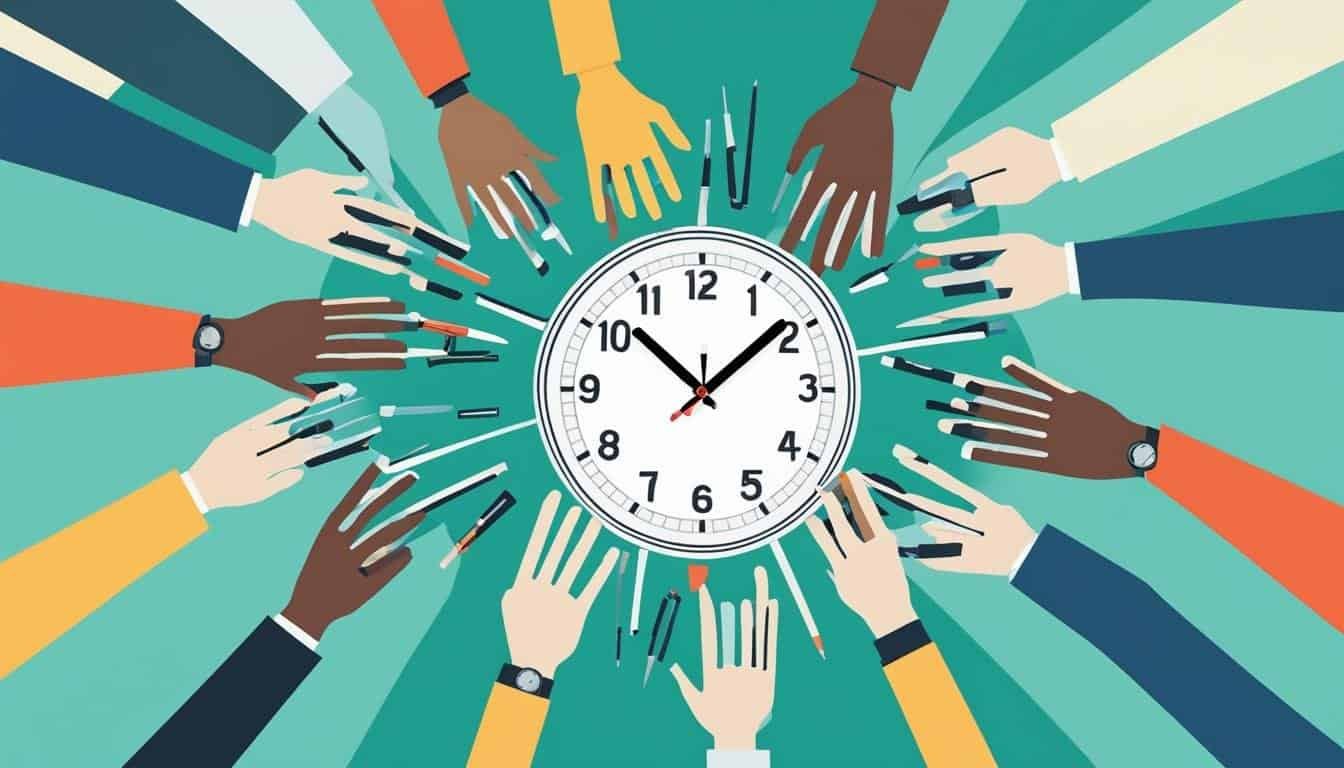Maximize Your Day with Time Optimization Tips
Time optimization is the key to maximizing productivity and achieving more in your day. By effectively managing your time, you can prioritize tasks, reduce stress, and make every moment count. In this article, we will explore different techniques and strategies to optimize your time and improve your time management skills.
Key Takeaways:
- Efficient time management allows you to prioritize tasks effectively.
- Prioritization and planning are essential for optimizing your time.
- Reducing stress through breaks and stress reduction techniques improves productivity.
- Goal-setting helps maintain motivation and track progress.
- Implementing time-saving techniques and leveraging technology enhances efficiency.
The Benefits of Good Time Management Skills
Good time management skills have numerous benefits. They enable individuals to prioritize their tasks effectively, ensuring that higher-priority tasks are completed first. By managing time efficiently, individuals can maximize their productivity and achieve their goals. Effective time management involves identifying urgent tasks, planning schedules, reducing stress, setting clear goals, and communicating effectively. These skills empower individuals to make the most of their time and achieve optimal results in their personal and professional lives.
When we have strong time management skills, we can prioritize our time effectively, ensuring that we focus on the tasks that matter most. By allocating appropriate time to important tasks, we ensure that they receive the attention they deserve. This allows us to accomplish our goals efficiently and effectively.
Effective Time Utilization
“Time management is about life management.” – Brian Tracy
Time management skills also enable individuals to effectively utilize their time. By understanding how to allocate their time, individuals can ensure that every minute is spent in a manner that aligns with their goals and aspirations. Instead of wasting time on unimportant or non-essential tasks, individuals with effective time management skills are able to utilize their time in a way that maximizes their productivity. This not only increases efficiency but also provides opportunities for personal growth and development.
Effective time utilization involves planning and organizing tasks, allocating appropriate time for each task, and focusing on completing them within the designated time frame. By using time wisely, individuals can accomplish more, pursue new opportunities, and lead a fulfilling and successful life.
| Benefits of Time Management Skills |
|---|
| Prioritization of tasks |
| Increased productivity |
| Reduced stress levels |
| Clear goal setting |
| Effective communication |
Embracing good time management skills offers a multitude of benefits. It helps individuals prioritize their tasks effectively, allowing them to focus on what matters most. With efficient time utilization, individuals can achieve high levels of productivity and make significant progress towards their goals. By developing these skills, individuals can enjoy a less stressful and more organized life, leading to personal and professional success.
Next, we will explore the importance of prioritization and planning in effective time management.
Prioritization and Planning
Prioritization is an essential aspect of effective time management. By assigning priority levels to tasks, you can focus your attention on the most important ones. It allows you to make informed decisions on what tasks require immediate attention and what can be deferred. Effective prioritization helps you manage your time more efficiently and ensures that you allocate your resources to tasks that yield the greatest results.
One crucial step in prioritization is creating a comprehensive task list. Take the time to brainstorm and write down all the tasks that need to be accomplished. This will help you have a clear overview of your workload and enable you to identify priority tasks.
Creating a Task List
- Use the daily planner app to start by listing all the tasks you need to complete.. Be as specific as possible to avoid confusion and ensure clarity.
- Consider factors such as deadlines, dependencies, and urgency when assigning priority levels to each task. This will help you determine which tasks are time-sensitive and require immediate attention.
- Group similar tasks together to streamline your workflow. This will allow you to work efficiently and minimize distractions.
- Regularly review and update your task list to reflect any changes or new priorities that may arise.
Once you have your task list, it’s crucial to set realistic deadlines. Deadlines provide a sense of urgency and help you stay focused. When setting deadlines, consider the complexity and duration of each task, as well as other commitments you may have. Be mindful not to overcommit yourself and ensure that you allocate sufficient time for each task.
With your task list and deadlines in place, it’s time to plan your workflow. Effective planning involves creating a schedule that outlines when and how you will work on each task. Consider your peak productivity hours, energy levels, and any potential interruptions. Allocate dedicated time blocks for specific tasks, ensuring that you have sufficient time to complete them without rushing.
Remember to build in buffer time for unexpected events or contingencies. By allowing flexibility in your schedule, you can better adapt to unforeseen circumstances and avoid unnecessary stress.
Ultimately, prioritization and planning go hand in hand. By prioritizing your tasks and creating a well-structured plan, you can optimize your time, stay organized, and increase your productivity.
Stress Reduction Techniques
Stress can have a significant impact on our productivity levels, making it crucial to effectively manage and reduce stress for optimal time management. By implementing various stress reduction techniques, you can maintain focus, stay motivated, and increase your overall productivity throughout the day.
Take Breaks and Recharge
One effective stress reduction technique is to take regular breaks. Stepping away from your work for a few minutes allows your mind to recharge and helps prevent burnout. Use your break time to stretch, meditate, or engage in a relaxing activity. Taking short breaks throughout the day can improve focus and productivity when you return to work.
Go for a Walk
A simple walk can do wonders in reducing stress. Take some time to go outside and connect with nature. The fresh air and exercise will help clear your mind and improve your mood. Use your walking breaks to release tension and gain a new perspective, allowing you to return to your tasks with renewed energy and focus.
Practice Meditation
Meditation is a powerful technique for stress reduction. By focusing on deep breathing and mindfulness, you can calm your mind and reduce anxiety. Find a quiet space, close your eyes, and let go of any negative thoughts or distractions. Regular meditation practice can improve your ability to handle stress and enhance your overall well-being.
Contact a Friend
Connecting with a supportive friend or loved one can provide emotional relief and help alleviate stress. Reach out and share your thoughts and feelings with someone you trust. Expressing your emotions and receiving support can provide a fresh perspective and help you regain focus and motivation.
Remember, stress reduction is vital for effective time management. Taking breaks, going for walks, practicing meditation, and connecting with loved ones are just a few stress reduction techniques worth incorporating into your daily routine.
Engage in Hobbies
Engaging in hobbies that bring you joy and fulfillment is an excellent way to reduce stress. Whether it’s painting, playing a musical instrument, cooking, or gardening, making time for activities you love can help you relax, recharge, and refocus. Hobbies provide a healthy outlet for stress and contribute to your overall well-being.
Listen to Music
Listening to music has been proven to have a positive impact on our mood and stress levels. Create a playlist of your favorite songs that uplift and inspire you. Whenever you feel overwhelmed or stressed, put on some music and let it calm your mind. The soothing melodies can help you regain focus and boost your productivity.
Implementing stress reduction techniques into your daily routine is a key element of effective time management. By prioritizing your well-being and managing stress levels, you can enhance your productivity, achieve greater success, and lead a more balanced life.
Goal-Setting for Time Optimization
Setting clear goals is a fundamental component of effective time management. When you define specific goals and break them down into manageable tasks, you gain a sense of direction and purpose. Not only does goal-setting help you prioritize your tasks, but it also boosts your efficiency and motivates you to achieve milestones along the way.
By setting achievable goals, you create a roadmap for success. Each goal acts as a stepping stone towards your larger objectives, ensuring that your efforts are well-aligned and focused. As you accomplish each task, you experience a sense of accomplishment which further fuels your motivation and propels you towards greater efficiency.
Goal-setting also provides clarity in your daily activities. With clearly defined goals, you can evaluate which tasks are essential and directly contribute to your desired outcomes. This allows you to streamline your efforts, eliminate non-essential tasks, and allocate your time and energy more efficiently.
“Goals are the roadmaps that guide you to your destination of success.”
Moreover, goal-setting serves as a source of intrinsic motivation. When you have a clear vision of what you want to achieve, you become more invested in your work, driving you to stay focused and committed. Each accomplishment serves as a reminder of your progress, reinforcing your determination and resilience.
By combining goal-setting with stress management techniques, you can optimize your time and achieve more in a structured and efficient manner. Clear goals not only serve as a compass for your actions but also provide a sense of purpose and fulfillment as you make progress towards your ultimate aspirations.
Techniques for Time Optimization
Time optimization is crucial for maximizing productivity and efficiency. By implementing the following techniques, you can streamline your workflow and make the most of your available time.
Start Tasks Promptly
One of the most effective time-saving techniques is to start tasks as soon as possible. Procrastination only delays progress and adds unnecessary stress. By tackling tasks head-on, you can maintain momentum and accomplish more in less time.
Set Boundaries
Setting boundaries for the amount of work you accept is essential for managing your time effectively. Learn to say no when your workload becomes overwhelming or when tasks don’t align with your priorities. By setting limits, you can focus on high-value activities that align with your goals.
Take Regular Breaks
While it may seem counterproductive, taking regular breaks is essential for maintaining concentration and productivity. Stepping away from your work allows your mind to recharge, reducing mental fatigue and boosting focus when you return. Use this time to relax, stretch, or engage in activities that rejuvenate you.
Make Task Lists and Prioritize
Creating task lists and prioritizing them helps you stay organized and focused. Write down all your tasks and rank them based on urgency and importance. This allows you to tackle high-priority tasks first and ensures that nothing falls through the cracks.
Organize Your Work Environment
A cluttered work environment can hinder productivity and waste valuable time. Take the time to organize your workspace, ensuring that everything is easily accessible and in its proper place. A clean and organized environment promotes focus and efficiency.
Recognize Productivity Patterns
Everyone has their own productivity patterns. Some people work best in the morning, while others are more productive in the afternoon or evening. Identify your peak productivity time and schedule your most important tasks accordingly. By aligning your work with your natural rhythm, you can maximize your output.
Leverage Technology
Technology can be a powerful tool in optimizing your time. Utilize productivity apps and software to manage your tasks, set reminders, and track your progress. Use time management apps that block distracting websites or send reminders for taking breaks. Technology can help you stay on track and make the most of each minute.
Focus on One Task at a Time
Multitasking may seem like a time-saver, but it actually hampers productivity. Research has shown that focusing on one task at a time leads to better results. By dedicating your full attention to each task, you can complete them more efficiently and with higher quality.
Reinforce Positive Behaviors
Building positive habits is instrumental in time optimization. Reward yourself when you achieve your goals or complete tasks ahead of schedule. Celebrate your accomplishments and use positive reinforcement to motivate yourself to continue prioritizing your time effectively.
By implementing these time-saving techniques and leveraging technology, you can optimize your time, increase productivity, and achieve your goals more efficiently.
The Power of Single-Tasking
Contrary to popular belief, multitasking is not an efficient way to get things done. Research shows that multitasking reduces productivity. Instead, focus on single-tasking. Give each task your full attention before moving on to the next. This allows you to complete tasks faster and with greater accuracy. Avoiding multitasking and staying focused on one task at a time will improve your time management skills and overall productivity.
When you attempt to multitask, your brain has to constantly switch gears between different tasks. This constant switching not only slows you down but also leads to errors and a decrease in the quality of your work. On the other hand, single-tasking allows you to fully immerse yourself in a task, harnessing your focus and attention to accomplish it more efficiently and effectively.
By dedicating your attention to a single task, you can experience a state of flow, where you are fully engaged and deeply concentrated. This flow state enhances your productivity and enables you to perform at your best. You will find that you can complete tasks more quickly and with better results when you give them your undivided attention.
“The ability to concentrate and use time well is everything.” – Lee Iacocca
Single-tasking also improves your ability to prioritize. When you focus on one task at a time, you can better evaluate its importance and urgency, allowing you to make better decisions about how to allocate your time. By tackling tasks individually, you give yourself the opportunity to assess their impact and adjust your priorities accordingly.
Furthermore, single-tasking reduces mental clutter and overwhelm. When you have too many tasks vying for your attention, it’s easy to feel overwhelmed and struggle with decision-making. By focusing on one task at a time, you can eliminate distractions and concentrate on the task at hand, leading to a clearer mind and improved decision-making.
Remember, single-tasking doesn’t mean you have to work on one task until it’s complete before moving on to the next. It simply means dedicating your full attention to one task at a time, completing it to the best of your ability, and then shifting your focus to the next task. Breaking your workload into manageable chunks and approaching them one by one will help you maintain momentum and make steady progress.
The Benefits of Single-Tasking:
- Enhanced focus and concentration
- Increased productivity and efficiency
- Better task prioritization
- Reduced mental clutter and overwhelm
- Improved decision-making
By embracing single-tasking, you can unlock the power of focus and optimize your time management skills. Give yourself the gift of undivided attention to tasks, and watch as your productivity soars.
The Importance of Breaks and Tools for Productivity
Maintaining high productivity requires recognizing the importance of breaks and leveraging productivity tools. Your brain needs regular rest and downtime to recharge, allowing you to stay focused and perform at your best. Incorporating breaks into your daily routine can help prevent burnout, improve concentration, and boost your overall performance.
Take Strategic Breaks
One effective technique for scheduling breaks is the Pomodoro technique. This method involves working in focused blocks of time, typically 25 minutes, followed by short breaks of 5 minutes. After completing four consecutive work sessions, take a longer break of around 15-30 minutes to recharge fully. This structured approach to breaks helps maintain your energy levels and enhances your productivity throughout the day.
Another popular technique is the 52/17 rule, which suggests working for 52 minutes and then taking a 17-minute break. This cycle is based on research indicating that the most productive people work intensely for concentrated periods and then give themselves ample time to rest and recharge.
Utilize Productivity Tools
There are numerous productivity tools available to help you effectively manage your time and tasks. These tools leverage technology to streamline your workflow and enhance your productivity:
- Electronic planners or calendar apps: These tools allow you to organize and prioritize your tasks, set reminders, and track deadlines.
- Messaging apps for quick communication: Instant messaging platforms facilitate efficient and immediate collaboration with colleagues, eliminating the need for lengthy email exchanges.
- Email shortcuts: Utilize keyboard shortcuts and email filters to efficiently navigate through your inbox and quickly respond to important messages.
- Timer apps: Timer apps can help you stay focused and manage your time effectively by allocating specific time blocks for tasks.
- Collaborative platforms: Online platforms that enable real-time collaboration and document sharing enhance teamwork and simplify project management.
By incorporating these productivity tools into your daily routine, you can streamline your workflow, stay organized, and manage your time more efficiently. These tools empower you to prioritize tasks, communicate effectively, and track your progress, ultimately leading to increased productivity and better time management.
Conclusion
Mastering the art of time optimization is the key to unlocking a world of possibilities. By implementing the proven techniques and strategies discussed in this article, you can take control of your time and maximize your productivity each day. Whether you are an aspiring professional or a seasoned executive, the principles of effective time management can pave the way for career advancement and personal growth.
Remember to start by prioritizing your tasks to ensure that you focus on what truly matters. By planning your schedule and breaking down your goals into manageable steps, you can navigate through your day with clarity and purpose. Managing stress is also crucial in the pursuit of better time utilization. Embrace stress reduction techniques such as taking breaks, practicing meditation, and engaging in activities that bring you joy.
Furthermore, don’t underestimate the power of setting clear goals. By defining your objectives and establishing a roadmap to achieve them, you create a sense of direction that propels you forward. Embrace the practice of single-tasking, dedicating your full attention to each task at hand, and avoiding the pitfalls of multitasking. Remember to make time for rejuvenation by incorporating breaks into your schedule, allowing your mind to recharge and refocus.
To further optimize your time and accelerate your career advancement, consider partnering with Akkodis. With their expertise in time management strategies, they can provide you with personalized coaching and innovative tools to amplify your effectiveness. By investing in your time optimization skills, you can unlock new opportunities and reach new heights in your personal and professional life.






